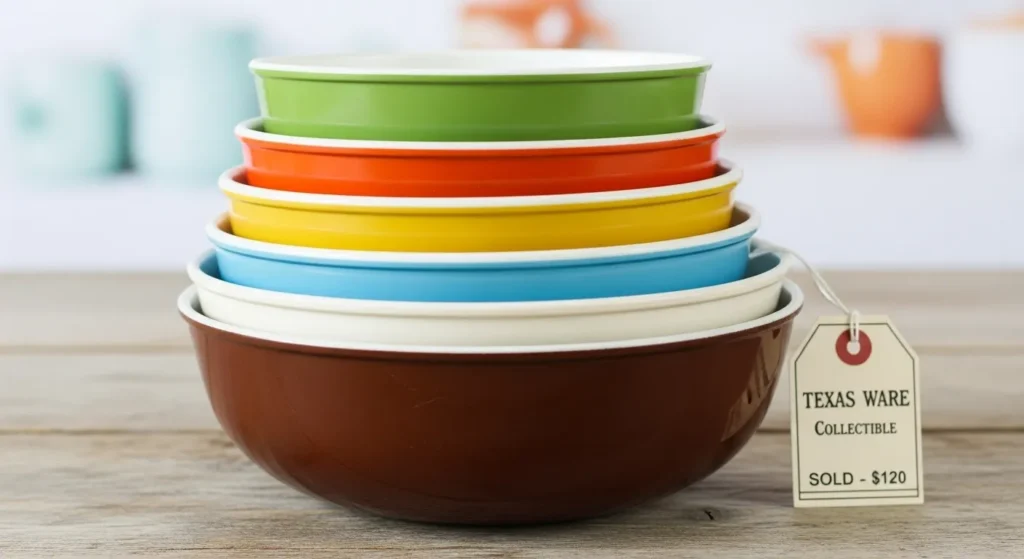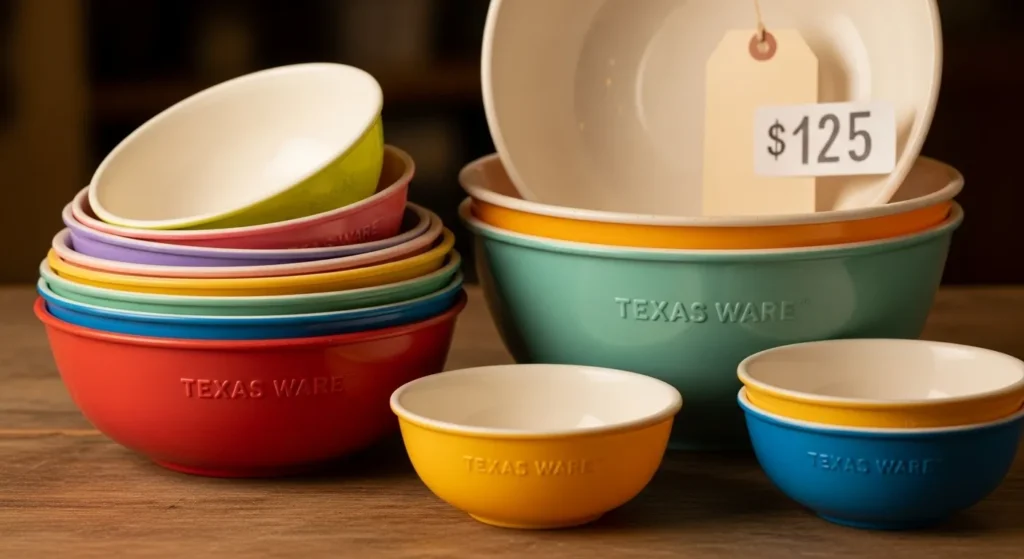Table of Contents
I still remember the first time I held a Texas Ware bowl. It wasn’t just another piece of kitchenware; it felt like history in my hands. You might have thought the same if you’ve ever stumbled upon one at a flea market or inherited it from a family member. But then comes the big question: why are Texas Ware bowls so expensive? Let’s dive into the real reasons together.
A Look Back at Their Story
When we talk about these iconic bowls, we’re talking about a piece of mid-20th-century American design. They were made in Dallas, Texas, from the 1950s to the 1990s. Their signature swirled melamine patterns, especially the confetti style, made them stand out. He bought one in the 1980s for his first apartment, and she still uses it today as a popcorn bowl for her kids. This longevity is part of their charm.
What Makes Them Rare Today

They don’t make Texas Ware anymore. That alone pushes up demand. Collectors like us, you, and them are chasing after a limited supply. Once a piece is gone, it’s gone. Unlike mass-produced plastic bowls today, these were crafted in smaller runs with unique swirls, so no two are exactly alike.
The Nostalgia Factor
For many people, it’s not just about the bowl. It’s about what it represents. He remembers his grandmother mixing cake batter in one. She remembers her college roommate eating noodles out of another. These emotional ties make them priceless to individuals, and that drives prices up in the market.
Comparing Everyday Costs
You might wonder: why not just buy a new set of mixing bowls for $20 at the store? Here’s the difference:
- Regular bowls: Cheap, replaceable, no story.
- Texas Ware bowls: Durable melamine, collectible designs, historical value.
- Market prices: A set can run from $200 to $400 depending on condition.
That price tag looks steep, but it matches what serious collectors are willing to pay.
The Role of Craftsmanship
Unlike fragile ceramics or modern plastics, Texas Ware bowls were engineered to last. The melamine used was tough, stain-resistant, and almost unbreakable. When I drop my modern glass bowl, it shatters. When they drop their Texas Ware, it bounces. That durability adds long-term value.
Popular Styles That Command More Value
Not all designs are equal in cost.
- Confetti patterns (multi-color swirls) fetch the highest prices.
- Solid colors are more affordable but still collectible.
- Unique swirl mixes (like green-and-gold or blue-and-white) often land somewhere in the middle.
Collectors chase after the rarer designs, which explains why some listings skyrocket.
Parallels With Other Expensive Hobbies

To put it in perspective, think of lawn bowls, a centuries-old sport that also involves collectible, durable equipment.
- Originated in the 13th century.
- Played worldwide in over 50 countries.
- Equipment (bowls) costs $200–$400, just like Texas Ware.
- Special designs, sizes (00–5), and materials increase costs.
- People still pay because of heritage, quality, and social value.
This shows how both kitchen and sporting collectibles gain value from history, rarity, and cultural importance.
A Collector’s Market at Work
Just like coins, stamps, or vintage Pyrex, Texas Ware bowls thrive in a collector’s economy. Supply is low, demand is high, and values climb. I once saw a confetti Texas Ware bowl sell for $350 on eBay. They saw one listed in an antique shop for $500. Prices depend on condition, color rarity, and buyer passion.
Personal Stories Add to the Worth
Sarah, a 45-year-old office worker, once told me about finding her first Texas Ware bowl at a garage sale. She paid $2. Later, she discovered it was worth over $150. For her, it wasn’t just about the money—it was about connecting with her childhood memories of watching her mom cook. That’s how personal meaning transforms into market value.
Mistakes to Avoid When Buying
If you’re thinking about collecting, don’t rush.
- Check condition: Chips and cracks lower value.
- Know the patterns: Confetti = higher value.
- Don’t overpay: Compare online sales before buying.
- Be patient: Good deals come with time.
Many people, me included, made the mistake of grabbing the first bowl we saw, only to realize we could have found a better piece later.
How to Start Without Breaking the Bank

If you’re new, here’s a quick path:
- Discover – Visit flea markets or thrift shops.
- Develop – Learn the swirl patterns and price trends.
- Drill – Compare listings online to sharpen your eye.
- Deploy – Make your first buy, focusing on enjoyment over investment.
This mirrors the “4D Path” I’ve seen used in lawn bowls training: discover, develop, drill, and deploy. It works beautifully for collectors too.
Beyond the Price Tag: The True Value
Yes, Texas Ware bowls are expensive. But the cost is not just dollars. It’s about owning a slice of design history, a link to family traditions, and a conversation starter in your kitchen. He might see it as a smart investment. She might see it as a keepsake. For me, it’s both.
Final Thoughts
So, why are Texas Ware bowls so expensive? Because they are rare, durable, nostalgic, and collectible. They sit at the intersection of history, design, and emotion. You might not buy one for everyday cereal, but if you, me, or them hold one in our hands, we’re holding a story that’s worth far more than its price tag.
If you ever spot one in the wild, think twice before walking away it might just be the most valuable bowl you’ll ever own.
References and Sources
- Production era of Texas Ware bowls
Mid-20th century through the late 1900s, especially 1950s–1970s (peak popularity). - Material and craftsmanship
Durable melamine construction, known for long-lasting, iconic swirl patterns—especially the “confetti” style. - Collector demand and rarity
No longer in production, limited runs, unique patterns, cementing scarcity and collectible appeal. - Emotional and nostalgic appeal
Examples of family memories, inherited usage, and personal stories that drive perceived value. - Market value comparisons
Price estimates: $200–$400 for quality examples, especially in confetti or rare patterns; parallels drawn with lawn bowls equipment pricing.
FAQs
Why are Texas Ware bowls so expensive?
They’re no longer made, supply is limited, and certain confetti patterns are highly collectible. Condition, size, and color mix also push prices up.
What years were Texas Ware bowls produced?
Mid-20th century through the late 1900s, with peak popularity from the 1950s–1970s.
Which patterns are most valuable?
Multicolor “confetti” and rare swirl combos often command the highest prices. Unique, vivid, and evenly distributed chips tend to sell best.
How do I tell real Texas Ware from look-alikes?
Check for molded marks, weighty melamine feel, crisp edges, and period-authentic wear. Compare known shapes and rim profiles from trusted references or seller photos.
Disclaimer: Prices, values, and opinions shared are for informational purposes only and should not be taken as financial or investment advice.




